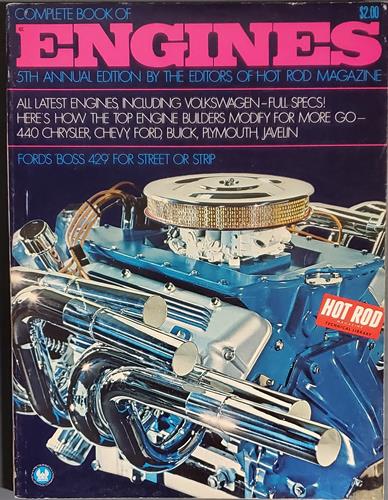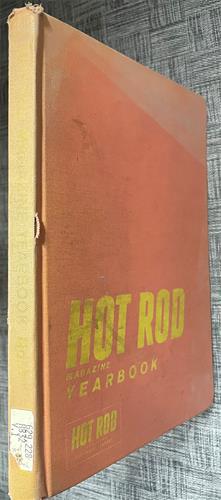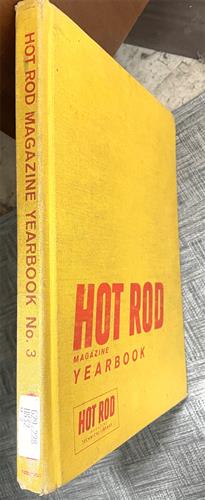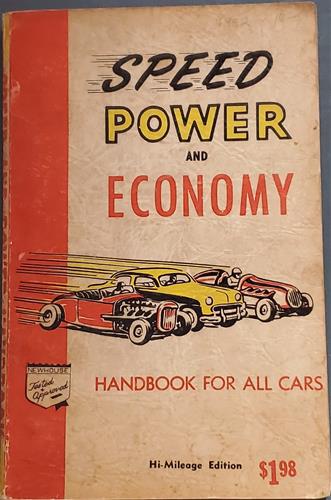
Illustrated with evocative period photos, this paperback reprint of The American Hot Rod (0-87938-982-6) traces the evolution of the cars built and modified specifically for street, track and salt flats racing from the 1920s through the early 1970s. Chapters cover topics like dry lakes racing, prewar Fords, Detroit engines, road racing specials, supercharging and alternative fuels, Bonneville and drag racing.
Dry Lakes and Drag Strips is a classic devoted to the birth and early years of the Hot Rod movement. Written by the late writer and editor Dean Batchelor, this book should be on the shelf of every serious American automobile enthusiast and especially hot rodders.
In the early years of American motorsports there was not a grand distinction between automobiles and enthusiasts of different stripes. Wealthy and glamorous spectators could be seen at a midget dirt track race, a board-track event or one of the early-century road races that were held on unpaved courses from Long Island to Santa Monica. Racing was racing, and all of it was hot, dirty and extremely dangerous.
During World War II, all forms of motorsport were put on hold while drivers and mechanics served in uniform or worked in aircraft factories. Then, in the post-war era, hot rodders who usually raced Fords that they modified themselves began to be seen as a lower class of automotive enthusiasts than drivers who could simply write a check for an exotic Jaguar or Maserati or even one of the slippery new Ferraris from Italy. Even the word "hot rod" which was coined about 1945 to describe the fenderless, re-shaped cars many of the young enthusiasts favored, became a pejorative.
Meanwhile, road racing became glamorous and 1950s events were held on courses in tony places like Bridgehampton on Long Island, Lime Rock in Connecticut and Pebble Beach on the Carmel Peninsula. While many road racers either came from prep school backgrounds or worked to give people that impression, the men who raced hot rods and started drag racing came from lower or middle class backgrounds. As the years went on, these distinctions seemed to harden, so there were many serious automobile enthusiasts on one side or the other of this divide who knew almost nothing about the other type of racing and there was little cross-over between hot rodders and sports cars, except occasionally for Corvette enthusiasts.
This is a long and roundabout way of introducing the author of Dry Lakes and Drag Strips, Dean Batchelor, for he was the rare person who bridged these two worlds, the world of dry-lake and drag racing and the sports car planet with its Ferraris, Porsches and Jaguars. Batchelor was mechanically and artistically inclined and one of the many car enthusiasts who served in the air force during or after the war. Batchelor was shot down over Germany, became a P.O.W. and then returned home and became one of the movers and shakers in the post-war hot rod movement. He raced on the dry lakes and used his design skills to help create an important early streamliner, the flathead powered So-Cal Special, which he built with Alex Xydias and then drove to a speed of 190 miles at hour at Bonneville in 1949.
In addition to his mechanical abilities and talent for design, Batchelor wrote well, with both precision and clarity, and in the 1950s he began working as an editor for Hop Up, a digest-sized hot rod publication. He then he made the jump to John and Elaine Bond's Road & Track Magazine, which had rapidly become the bible of the sports car set. Working for R & T, Batchelor became a sports car enthusiast and in particular a Ferrari devotee. The Italian cars clearly appealed to his love of design and his appreciation for mechanical complexity. After he left Road & Track, Batchelor wrote a series of books on the history and development of early Ferrari sports cars.
While men had been testing their modified cars on the dry lakes in the California high desert since the late 1920s, the war years had created a pent-up demand in the young men who had a need for speed, and things got going again soon after the Germans and Japanese were vanquished. While before the war drivers raced their cars on the huge, flat surface of Muroc Dry Lake, the Army Air Force had taken over this lakebed for the vast flight-test facility that became Edwards Air Force Base, where the sound barrier was broken. So the racing action moved to some of the other lakes in the area, most prominently El Mirage.
In his book, Batchelor covers the birth and gestation of the hot rod sport with a straightforward, chapter-by-chapter narrative along with a number of sidebars that have more detail on a particular person or subject. It is an excellent way to work for a project of this type as the narrative doesn't get bogged down with two much detail, but the information is there if the reader wants it. In the first chapter Batchelor summarizes pre-war racing on the lakes, where the top speeds were right around 120 miles per hour, and the birth of the speed shop; chapter two focuses on the ubiquitous Model T Ford, the inexpensive automobile that became the raw material for most early hot rods and that had an engine that much of the early speed equipment was made for. Chapter 3 covers the famous Model "A" and later Fords that superseded the "T's," and chapter 4 summarizes the birth of the hot rod culture on the dry lakes and streets of Southern California. Batchelor had a great understanding of the technology of the time and he writes of the development of the Ford "Flathead" V-8 and other engines in chapters 5 and 6.
The clubs and associations were the glue that held the hot rod scene together, and there were dozens of clubs throughout Southern California with names like the Mobilers, the Throttlers, the Pasadena Roadster Club, the Outriders and the Road Runners, some of which are still in existence. A well-organized sanctioning body, the Southern California Timing Association (the S.C.R.A.), was formed in 1937. Originally its meets favored open roadsters, but eventually it gave structure to the entire sport of land-speed-record racing, creating a vast array of classes and running annual events on the Bonneville Salt Flats as well as frequent speed trials on the flat, dusty surface of El Mirage.
During the 1950s there was a great deal of street racing activity, and it was these dangerous impromptu and semi-organized races that created a negative image for street rodders. After all, the dry lakes were a long way away, while there were long, smooth, open stretches of road all over Southern California. In the early 1950s some of the more responsible members of the hot rod clubs decided that there needed to be a new organization to create shorter, ¼-mile events where young drivers could test and race their cars, and this is how the sport of drag racing was born. There is a nice capsule biography in the book to Batchelor's friend, the recently-departed Wally Parks, the first editor of Hot Rod, who founded the National Hot Rod Association in 1951. Drag racing began on unused airstrips, but soon purpose-built strips were operating and the N.H.R.A. Safety Safari was touring the country to encourage racing at sanctioned events, under controlled conditions, rather than on the street. As drag racing grew, racing on the lakes became a specialized activity, kept going by a group of die-hard enthusiasts.
Now, there was some crossover between the sports car and hot rod crowds and these were the road-racing specials that Batchelor knew so well and wrote about in chapter 8. These "specials" were just hot rods that were created to race around road circuits rather than in straight-line competition. Built by clever, "seat of the pants" engineers like Ak Miller and Max Bakchowsky, these ungainly roadsters often beat the glamorous Ferraris, Maseratis and Jaguars in road racing events, many of which were also held at unused military airports. There was always some resentment of the hot rodded specials from some of the wealthy car owners, but their speed was undeniable.
Batchelor covers forced induction - superchargers - in chapter 9 as well as exotic fuels that helped boost the performance of early racers. Though they are mentioned earlier, Chapter 10 is devoted to the Bonneville Speed Trials, Chapter 11 summarizes the first few decades of early drag racing and Chapter 12 covers the men who built the speed equipment business. A number of the men Batchelor raced with came to start racing equipment companies in their garages, businesses that became going concerns and in some cases, large corporations. Men like Vic Edelbrock Sr., Mickey Thompson, George Wright and Fred Carillo saw a business opportunity in providing equipment for the growing hot rod movement. The concluding chapter is devoted to publications like Robert "Pete" Peterson's groundbreaking Hot Rod, Hop Up and Car Craft. Finally, there is a nice glossary of "Dry Lakes and Street Rod Lingo" and appendix with a chronology of early meets, a list of clubs, champions and early drag racing records.
In the post-war years, the hot rod was seen as part of an outlaw movement. Through the efforts of men like Dean Batchelor and his comrades, it was given structure and respectability. Now, the hot rod and the car crafting hobby is part of American cultural history, an era that is looked back on with fondness and nostalgia by people around the world. This uniquely American hobby, something from a simpler and more innocent time that was born on the streets and dry lakes of California, now has almost universal appeal. This fondly written book, which covers the origins of the sport better than any other, is a fitting epitaph for Dean Batchelor, a man whose life and career revolved around automobiles he loved.
Batchelor, Dean
Dry Lakes and Drag Strips: The American Hot Rod
192
10.00 x 10.00 x 0.50 inches





















